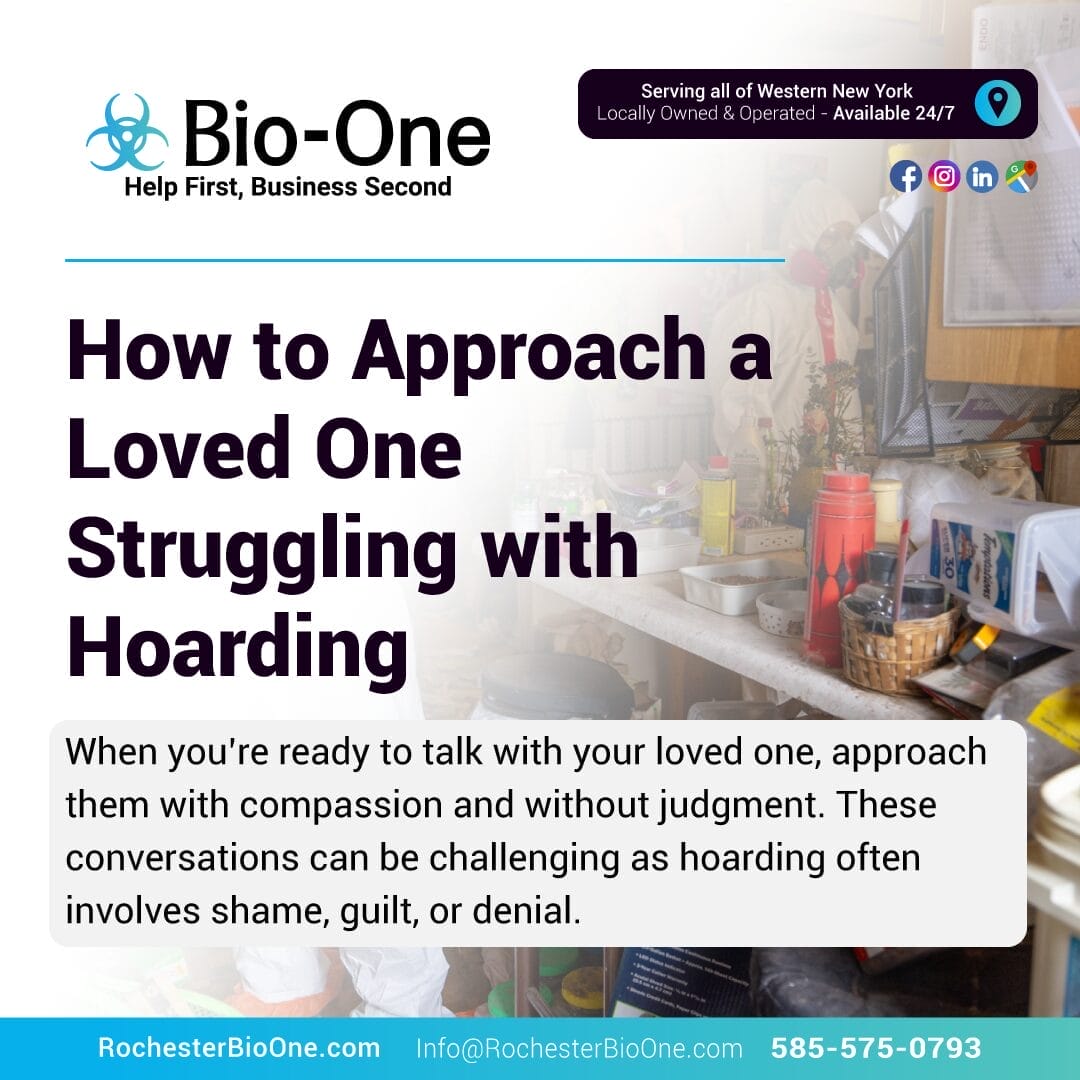
If you have a loved one who may be struggling with hoarding, you’ve likely experienced a mix of concern, frustration, and helplessness. Hoarding disorder is not just about collecting items; it’s a complex psychological condition that can affect a person’s health, safety, and well-being. Approaching a loved one about hoarding requires a great deal of empathy, patience, and understanding. By handling the situation thoughtfully, you can open the door to meaningful change and support their path to recovery.
Here are some compassionate and practical steps to take when approaching a loved one about hoarding.
Recognizing the Signs of Hoarding
Before starting a conversation, it’s important to recognize the signs of hoarding so you can approach the issue with an informed perspective. Some common indications include:
- Excessive Clutter: Rooms filled with items to the point where they’re no longer usable, such as beds, countertops, or furniture covered with belongings.
- Difficulty Discarding Items: A refusal or inability to throw away items, even those that might seem useless or broken.
- Distress or Anxiety at the Thought of Removal: Emotional upset when discussing decluttering or parting with possessions.
- Health and Safety Concerns: Unsanitary conditions, pest infestations, blocked exits, or other hazards caused by hoarding.
- Social Isolation: Avoiding visitors due to shame or embarrassment about the state of their living environment.
Understanding these signs helps build a foundation of empathy, which is key when broaching the topic.
Initiating the Conversation with Care
When you’re ready to talk with your loved one, approach them with compassion and without judgment. These conversations can be challenging as hoarding often involves shame, guilt, or denial. Here are some tips to ensure a constructive discussion:
- Pick the Right Time and Place: Choose a moment when your loved one is calm and open to conversation. Avoid busy or stressful times in their daily life.
- Express Concern, Not Criticism: Use “I” statements to communicate your feelings. For example, say, “I’m worried about your safety,” rather than accusing them with statements like, “You have a problem.”
- Be Patient and Listen: Allow your loved one to share their perspective without interrupting or dismissing their feelings. Listening builds trust and helps them feel understood.
- Avoid Labeling or Shaming: Phrases like “hoarder” or “messy” can make the person defensive or embarrassed. Use neutral language and focus on the situation rather than placing blame.
Remember, the goal of this conversation is not to force immediate change but to foster trust and open communication.
Understanding Emotional and Psychological Challenges
Hoarding disorder is often tied to deeper emotional struggles such as anxiety, depression, trauma, or grief. For many people, their possessions are connected to memories, identity, or a sense of security. Understanding these underlying factors can help you approach the issue with sensitivity.
- Validate Their Feelings: Acknowledge that parting with belongings can be difficult. Saying things like, “I know this feels overwhelming,” can show empathy and help them feel supported.
- Avoid Quick Fixes or Ultimatums: Demanding that they clean up right away can backfire and harm your relationship. Change happens gradually, and your loved one must feel ready to take steps toward improvement.
- Encourage Professional Support: A therapist or counselor trained in hoarding disorders can help address the emotional and psychological challenges involved.
Offering Support Without Judgment
When supporting someone struggling with hoarding, it’s important to strike a balance between helping and setting healthy boundaries. Here’s how:
Ways to Offer Support:
- Help with Small Steps: Offer assistance with manageable tasks, like organizing one small area or sorting items together.
- Provide Encouragement: Celebrate even the smallest victories to build their confidence and motivation.
- Explore Resources Together: Look into professional cleanup or therapy options as a team to remove some of the overwhelm.
Setting Boundaries:
- Protect Your Own Well-Being: While it’s natural to want to help, it’s critical to set limits to avoid burnout or resentment.
- Establish Clear Expectations: If their hoarding impacts shared spaces or responsibilities, calmly communicate your needs while respecting theirs.
- Step Back When Necessary: Recognize that you can’t solve the problem alone. A loved one must be willing to make changes for true progress to occur.
Seeking Professional Help
Hoarding often requires the expertise of professionals to address both the emotional and physical aspects of the disorder. This may include:
- Therapists or Counselors: Mental health professionals can help your loved one work through the emotional causes of their hoarding behavior.
- Professional Organizers: Specialists in decluttering can provide strategies for organizing and maintaining a clean space.
- Cleanup Services: Companies like Bio-One of Sacramento are trained to handle hoarding cleanup with care and discretion, ensuring safe and respectful removal of hazardous materials and cluttered items.
Professional cleanup services can be particularly effective in tackling the overwhelming physical challenges of hoarding, while leaving emotional and relational issues to the care of therapists and family.
Bio-One is Ready to Help!
Helping a loved one struggling with hoarding is never easy, but your compassion and support can make all the difference. By recognizing the signs, starting the conversation with care, and leaning on professional resources, you can empower them to take steps toward a safer, healthier life.
At Bio-One of Rochester, we understand the challenges families face when dealing with hoarding. Our team provides discreet, non-judgmental cleanup services tailored to your loved one’s needs. If you’re ready to take the next step, reach out to us today. Together, we can pave the way for recovery and restore safe, livable spaces.


